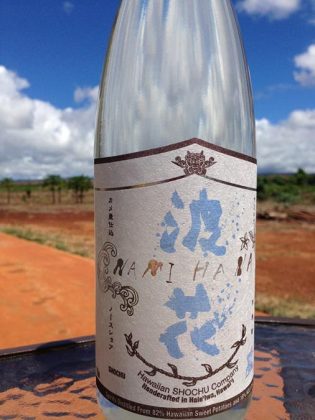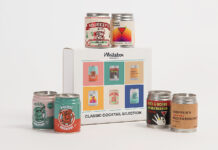For more than 200 years the histories of Japan and Hawaii have been intertwined. On May 5, 1806, the first Japanese people ever recorded to have set foot in Hawaii arrived as survivors of the cargo ship Inawaka-maru, which was carried into the Pacific Ocean by a severe storm and left adrift for two months. The eight survivors were rescued by an American ship and left in the care of King Kamehameha I. Since then, the Japanese and Americans of Japanese descent, who make up the second largest ethnic group in Hawaii, have helped to shape the physical and cultural landscape of the islands. Today, the Hawaiian Shochu Company, founded by Ken and Yumiko Hirata, is continuing this long history of Japanese and Hawaiian cross-cultural pollination.
The Hiratas have been distilling and selling their shochu, a traditional Japanese distilled spirit, made from rice and sweet potatoes, on Oahu’s North Shore for the past three years. Getting to this point was a long and circuitous road. Years ago, while Hirata was visiting his parents, who had moved to Honolulu from Osaka, he sampled poi, a traditional Hawaiian staple. (Poi is a mash made from baked or steamed taro root, often the consistency of pudding.) As Hirata ate the poi, it occurred to him that poi could make an interesting shochu. However, that thought receded to the back of his mind as Hirata returned to Hong Kong and his job brokering U.S. financial instruments.
From there Hirata moved to Osaka and worked with artists who made traditional Japanese ceramics and textiles. But after developing a skin condition, Hirata and his wife moved, this time to Australia. It was during this time in Australia that the idea of making traditional shochu began to take shape.
Around 2005, the Hiratas moved to Kagoshima, Japan, the epicenter of shochu production for the past 500 years. Ken Hirata determined that he wanted to apprentice with Toshihiro Manzen, a master distiller with more than 30 years of experience. Hirata described the process by which he approached Manzen for an apprenticeship as a kung fu film. Manzen’s distillery is tucked away in a remote valley outside Kagoshima, surrounded by forests and planted near a stream. Hirata wrote Manzen numerous letters and visited the distillery again and again, each time being turned down until Manzen finally relented and agreed to take Hirata on as an apprentice. Hirata spent three years there learning how to make a very traditional style of imo shochu distilled from rice and sweet potatoes.
In 2008, Manzen sent Hirata off to start his own distillery. Driven by his passion and training to create shochu from sweet potatoes, Ken and Yumiko returned to Hawaii. Besides its sheer beauty and relaxed pace of life, more than 20 varieties of sweet potato are grown on Oahu, including the white-skinned and purple-fleshed Okinawan sweet potato. Ken Hirata believed that the Okinawan sweet potato would give him the aromas and flavors he was looking for. Slowly the Hawaiian Shochu Company arose from the red dirt of Oahu’s North Shore with Hirata performing much of the work himself. Surrounded by the wild grasses of an old cane field, the Hiratas’ distillery is tucked away on a quiet road in the town of Haleiwa. While Honolulu is a bustling city that sees millions of tourists flock to Pearl Harbor and the beaches of Waikiki, Haleiwa, on the other side of the mountain, has a slower pace that feels much more relaxed.
The Hawaiian Shochu Company officially began production in 2013, making a traditional sweet potato shochu using methods and equipment that are hundreds of years old. Since the mid-sixteenth century the Japanese have been making shochu by distilling a fermented mash of rice or rice and other starches such as barley, sweet potato or buckwheat. However, rice and sweet potatoes need an external agent to break down their starches into sugar. While traditional distillers in the West have relied on malted barley to provide the diastatic power necessary to convert starches into fermentable sugars, Japanese distillers have relied on koji mold. This particular strain of mold is very well adapted to creating the enzymes necessary for starch conversion. Hirata sprinkles the mold over steamed white rice which has been spread out into shallow wooden boxes and left to be propagated in a specially designed room called the koji room. The koji room is designed to hold the temperature and humidity at the ideal levels for the mold to flourish. During this propagation phase, which takes about three or four days, Hirata, with his years of training, checks the temperature and moisture content of the rice with his hands.
However, neither the koji nor the rice Hirata uses are cultivated in Hawaii, which means he has to import them. He orders the koji direct from Japan, but instead of importing Japanese rice, Hirata uses an heirloom variety of rice grown in California by a Japanese American family.
After about three days, the koji mold has propagated throughout the steamed rice and Hirata is ready to begin the fermentation phase. When Hirata left to start his distillery, Manzen gifted him 15 handmade ceramic fermentors that range in age from 100 to 150 years old and which hold between 550 and 650 liters. The vats are about four feet tall and buried in the ground up to their shoulders, which helps stabilize the temperature of the fermenting mash. Hirata adds the inoculated rice, water and yeast to his vats and lets the fermentation begin. After a day or so, Hirata steams his Hawaiian-grown sweet potatoes and adds them to the fermentors. The enzymes present in the fermenting rice slurry break down the sweet potato starches into sugar, which is then quickly consumed by the yeast and converted into alcohol.
About a week into the fermentation, Hirata checks the aromas and flavor of the mash, which should be approximately 12% alcohol, to see if it’s ready to be distilled. Hirata uses a 1,700-liter steam-injected wooden still made from Japanese cypress. The mash of fermented rice and sweet potato is distilled in one pass and he collects the hearts in a large glass-lined steel holding tank. Hirata and his wife repeat this process for two months until the holding tank is full. The shochu rests in the holding tank at 40% ABV for up to six months before it is bottled. What comes out of the still is slightly harsh and bitter, but mellows during this rest period into a lightly sweet and wonderfully aromatic spirit.
Once the shochu has finished its rest period, it is ready to be bottled. Ken Hirata proofs the shochu down to 30% ABV and he is able to fill about 3,000 bottles per batch. Once the bottling begins, Yumiko Hirata starts the process of labeling every bottle of their shochu by hand. The name Namihana is written in both English and Japanese, which serves both their American and Japanese customers. In Japanese, Nami means waves and Hana means flowers. This name suits their shochu well because it has a strong character with lots of floral aromas. Their batch #2, which was made with sweet potatoes grown on Molokai, had a very fruity nose with notes of ripe pear and Fuji apple. On the palate, the shochu started slightly sweet with fruity and floral notes and finished dry with no heat from the alcohol. Overall the spirit is light, elegant and simply wonderful to drink.
Because of their two-month production cycle and the six-month rest period, the Hiratas are only able to produce and bottle two batches of shochu per year. While using traditional methods to make shochu limits their total output, they are solely focused on the quality of the spirit. The results have been very well received, and even though they produce about 6,000 bottles per year they quickly sell out of each batch they make. A few cases go to local restaurants and hotels on Oahu and the rest is sold directly to customers who visit the distillery.
Visitors who make their way to the Hawaiian Shochu Company are greeted at the gate with wooden signs written both in English and Japanese. This is useful because many of the people who come to taste Hirata and Yumiko’s shochu are Japanese tourists who have heard about their national spirit being made in Haleiwa. After parking in the dirt field next to the distillery, a friendly little dog name Imo (Japanese for sweet potato) greets visitors at the door. The guests are asked to remove their shoes and given slippers to wear inside the distillery, most of which are sized for people with smaller feet. Once inside, the distillery has a simple open floor plan, which allows visitors to see almost the entire production area from the entryway. Near the door, the Hiratas have a six-foot table with a few chairs where they sit with their visitors, pour samples and describe how they make shochu.
The Hawaiian Shochu Company is a perfect blend of a traditional Japanese distillery with the Hawaiian spirit of aloha. Hirata and Yumiko are exacting in the production and packaging of their shochu as well as relaxed, generous and welcoming. Hirata, who is an avid surfer, is not just making a shochu in Hawaii, but a Hawaiian shochu that represents the terroir of the islands in a way that has never been explored. Finally, any trip to Oahu should include a drive over the mountain to visit Ken, Yumiko and Imo.















